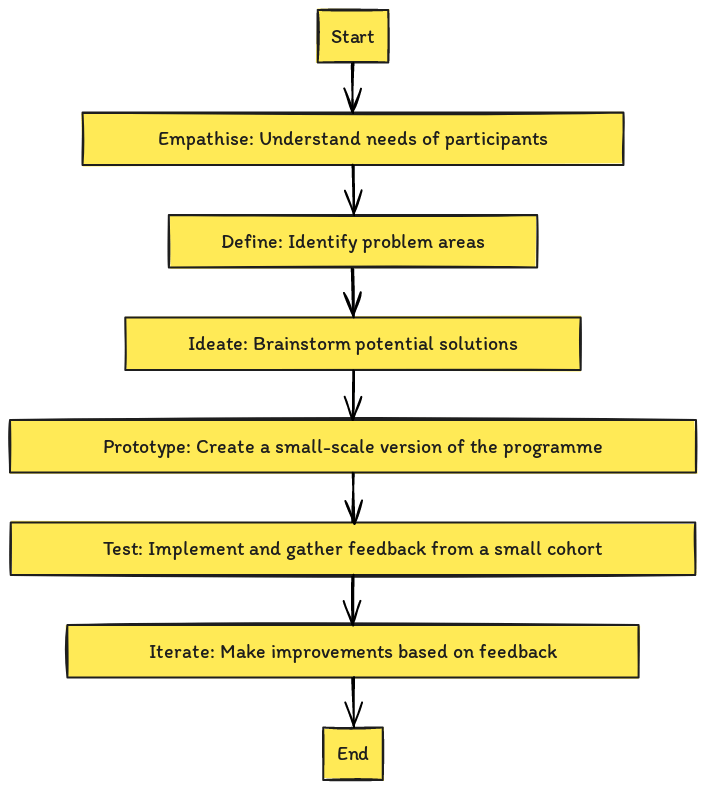Design thinking is not merely a buzzword but a human-focused methodology for solving intricate issues. Regarding apprenticeship programmes, design thinking becomes instrumental in developing well-rounded, inclusive training that benefits both employers and apprentices. This overview aims to shed light on the advantages of implementing design thinking in apprenticeship schemes and how to implement it effectively.
The Power of Design Thinking in Addressing Complex Issues
Known for its efficacy in problem-solving, design thinking prioritises understanding end-users needs. It empowers organisations to tackle seemingly overwhelming challenges, culminating in better services or products that stand a greater chance of market success. It empowers organisations to tackle seemingly overwhelming challenges, culminating in better services and bringing design thinking to the table for Apprenticeship Programmes. Design thinking enables the creation of apprenticeship schemes that are finely tuned to the needs of all involved parties—employers, trainers, apprentices and so on. This participative approach enhances retention and engagement rates, making the training more effective for everyone.
Creating More Equitable Apprenticeships
Design thinking is an inclusive method of designing programmes. It amplifies the voices of all contributors who shape the curriculum. This collective approach enhances collaboration among departments and external stakeholders, creating a more equitable learning environment.
The Anatomy of Design Thinking
Often attributed to global design consultancy IDEO, design thinking consists of five central stages: empathise, define, ideate, prototype, and test. These stages prioritise empathy and an in-depth understanding of the user, paving the way for more compelling solutions.
A Workflow for Design Thinking in Apprenticeships
- Empathise: This step involves deeply understanding the needs of everyone participating in the apprenticeship. Focus groups, interviews, and surveys can offer valuable
 insights, enabling a tailored approach to training.
insights, enabling a tailored approach to training. - Define: Insights from the initial stage inform the definition of problem areas in the current programmes. This clarity emerges from a targeted approach to improvements.
- Ideate: This is the creative stage where brainstorming comes into play. Through collaborative thinking, a plethora of potential solutions can emerge.
- Prototype: This involves creating a small-scale version of the training programme to test its efficacy and allow for improvements before the final rollout.
- Test: The prototyped solutions are implemented in real-world conditions among a small cohort of apprentices to gauge their impact. Based on this feedback, iterations are made.
Applying Design Thinking Across the Board
Design thinking is a versatile and user-centric methodology that can be effectively applied throughout various stages of an apprenticeship programme, from curriculum planning to post-training evaluations. In curriculum planning, design thinking encourages educators to empathise with apprentices, understand their needs, and tailor the curriculum accordingly. This ensures that the training is relevant and engaging. During the apprenticeship, design thinking can be used to assess and improve the programme continually. By regularly gathering feedback from apprentices and employers, educators can make informed adjustments to enhance the learning experience and ensure that the training remains aligned with industry demands. In post-training evaluations, design thinking helps identify the programme’s strengths and weaknesses, providing valuable insights to inform future iterations. This holistic application ensures that apprentices and employers derive maximum benefits, leading to a more effective and impactful apprenticeship programme.
Guidelines for Successful Implementation
- Include stakeholders in the entire journey: Successful implementation of design thinking in apprenticeship programmes requires the involvement of all relevant stakeholders, including apprentices, educators, and employers. Their perspectives are invaluable in shaping a programme that meets everyone’s needs. Stakeholder engagement ensures that the programme is not only well-rounded but also addresses the real-world challenges faced by both apprentices and employers.
- Make informed decisions based on user feedback: Collecting and analysing feedback from apprentices and employers regularly is essential. This feedback should inform decisions at every stage of the apprenticeship. By understanding users’ experiences and challenges, educators can make evidence-based adjustments to the programme. This iterative process helps create a more effective and responsive apprenticeship experience.
- Create a supportive space for free-flowing ideas: Design thinking flourishes in an environment that encourages creativity and open communication. Creating a space where ideas can flow freely without judgment encourages innovation. This supportive atmosphere allows stakeholders to contribute their insights and suggestions, leading to more innovative solutions and continuous improvement of the apprenticeship programme.
- Take a step-by-step approach, allowing for continuous refinement: Implementing design thinking is not a one-time effort but a continuous process. A step-by-step approach allows for ongoing refinement and adaptation. By breaking down the process into manageable phases, educators can focus on incremental improvements, ensuring that each apprenticeship stage is optimised based on feedback and observations.
- Set clear yet flexible goals: While it is important to have clear objectives, flexibility is equally pivotal. Design thinking requires adaptability to respond to emerging insights and changing needs. Setting goals that provide direction yet allow for adjustments ensures that the programme remains relevant and effective. This balance between structure and flexibility enables the apprenticeship to evolve in alignment with educational standards and industry requirements.
Conclusion
Design thinking offers a robust framework for optimising apprenticeship programmes. Its inclusive and iterative nature makes it possible to design training schemes that genuinely resonate with apprentices’ needs and aspirations. With appropriate resources and a well-thought-out strategy, design thinking can be a game-changer in the world of apprenticeships.






